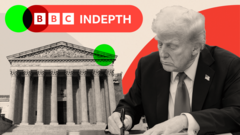In late May 2024, the atmosphere in lower Manhattan was charged as the jury deliberating Donald Trump's trial for hush money payments was expected to reveal its verdict. As speculation swirled about the outcome, the scene turned chaotic when the jury's decision came through: Trump was found guilty on all 34 charges, marking a historic moment as a former president now stood as a convicted felon.
Covering Trump's legal tribulations as the BBC’s North America correspondent, I have observed firsthand the myriad of charges facing him across various courts. As of now, the situation has flipped dramatically, with Trump's administration leveraging judgments from a reshaped Supreme Court to assert broad immunity from prosecution and undermine judicial authority. This empowered approach raises questions about how courts might defend against perceived encroachments on their power.
Prominent judges, both active and retired, have expressed concern over what they deem an unprecedented assault on the judiciary. Former judge John E. Jones III described the situation as a significant attack on district courts. Trump's administration has frequently criticized judges, labeling them in derogatory terms, while his deputy chief of staff claimed the U.S. is facing a “judicial tyranny.”
Amidst rising hostility, judges report experiencing unprecedented threats, including violent intimidation and personal harassment, contributing to an alarming environment for the judiciary. Statistics reveal over 400 threats to judges merely up to mid-2023, surpassing totals from the previous year. The implications of inflammatory remarks from leadership are raising alarms over inciting further aggression against judges.
While the current climate of aggression is alarming, some critics argue that systemic issues predate Trump's tenure. Advocates of the administration point to previous instances of hostility from the left, including threats against Supreme Court Justice Brett Kavanaugh. The divisive political discourse continues to shape perceptions of the judiciary’s role, particularly around contentious executive orders.
Trump's executive actions have surged, with significant government implications challenging existing laws and prompting numerous judicial pushbacks. The Supreme Court's ruling limiting judges' ability to issue nationwide injunctions illustrates tension between the executive branch's expansive use of orders and the judiciary's checks on these initiatives.
As Trump continues to confront judicial authority declaring him as "out of control," a philosophical clash emerges regarding the judiciary’s role in a democracy. Critics argue that judges' resistance to the president’s actions represents a core constitutional duty, while proponents of the administration contend that such judicial challenges obstruct the will of the people.
With constitutional expert Laurence Tribe characterizing the current political environment as "catastrophic," there remains an urgent debate over maintaining a balanced governmental framework. Trump’s administration must navigate a landscape where judicial pushback and legal complications are poised to unravel the very constitutionality they claim to uphold.
As the judiciary responds to the executive's overt challenges, the evolving dynamics reflect an ongoing struggle that will shape the very essence of U.S. governance and its pillars of democracy. The battle is far from concluded, and its ramifications for future presidents remain uncertain.





















